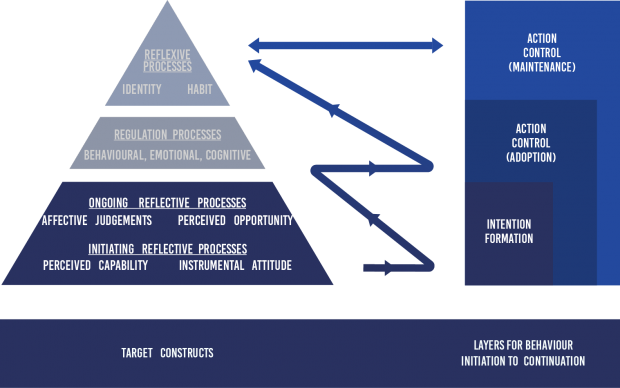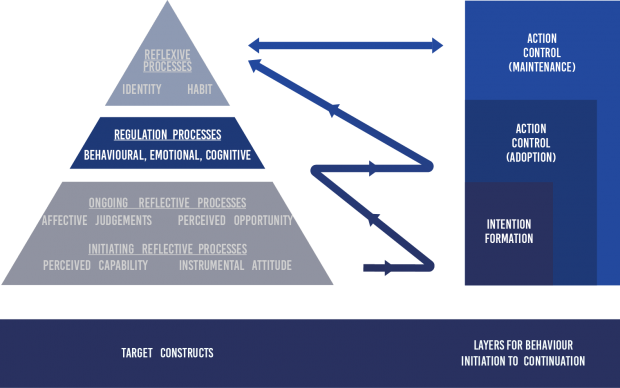Framework Breakdown
Layer 1
The first layer (Reflective Processes) is a representation of the consciously deliberated expectations of performing a behavior that culminate in the formation of an intention. This layer is entirely based on the substantive research from the social cognitive tradition (Bandura, 1998; Fishbein & Ajzen, 2010). In M-PAC, the key constructs are instrumental attitude, affective judgements, perceived capability, and perceived opportunity. Affective judgments and perceived opportunity are particularly important to both intention formation and action control because these expectations act as a proxy for the potential daily challenges (e.g., other goals, affect disruption,tendencies to conserve energy) that may thwart intention.
One likely needs higher levels of opportunity and affective judgments about physical activity to perform the behavior than to form the mere intention. These constructs are noted as “ongoing processes”. By contrast, instrumental attitude and perceived capability are considered far more stable from day to day. These expectations will affect the formation of the intention but are not as likely to impact its translation; the constructs are considered “initiating processes”. There are possibilities (e.g., clinical populations under treatment) where all constructs have import in both the formation of intention and its translation but these are considered exceptions where perceived capability and instrumental attitude fluctuate.
Layer 2
The second layer of the model (Regulatory processes) represents the tactics that are employed to manage action control. These constructs do not involve any motives or reasons for behavioral engagement; they are instead a series of behavioral, affective, and cognitive tactics to assist an individual in the selection of the intention over other possible options and to provide counter-measures against basic tendencies that may thwart the execution of the PA intention. These tactics broadly include planning, monitoring, contracting, self-reward, emotion regulation, distraction, and restructuring the environment (social, built). M-PAC conceptualizes regulation processes as a formative construct, where the volume of different tactics is a better determinant than any one (or few) tactic. M-PAC also suggests that these tactics may be a natural consequence of intention formation (i.e., spontaneous behavioral regulation), or modified via outside intervention.
Layer 3
The top layer (Reflexive processes) in M-PAC represents constructs that develop as a consequence of repeated action over time. Indeed, M-PAC suggests that regulatory processes in the second layer provide a kind of glue that allows action control to continue long enough for reflexive processes to develop and subsequently determine the sustainability, or maintenance, of physical activity action control. M-PAC includes two key reflexive constructs: habit and identity. Both constructs provide a drive toward the enactment of behavior independent of the reflective processes for enacting the behavior (i.e., based on stimuli). The exact time-frame for the length of reflexive processes to form is poorly understood but current estimates suggest habit may occur between six weeks and two-months if the conditions of consistency, cues, and pleasant affect are in place (Kaushal & Rhodes, 2015; Lally, van Jaarsveld, Potts, & Wardle, 2009). Identity may form within 2 months if the physical activity meets the conditions needed to produce a self-standard (Rhodes et al. 1015).



